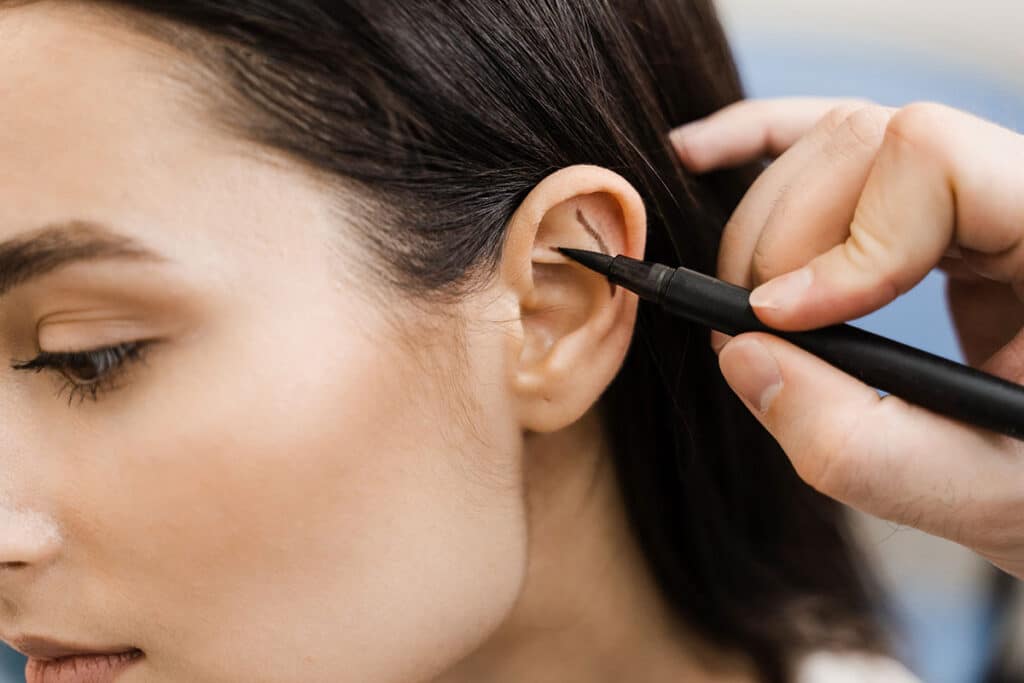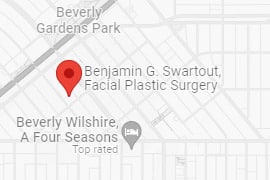
Have you considered the impact of your ear’s shape on your confidence or appearance? Otoplasty, a surgery aimed at reshaping the ear, offers a solution for those self-conscious about their ears. Dr. Benjamin Swartout, a renowned expert in facial plastic surgery, has advanced the field with his insights on incisionless otoplasty—a less invasive alternative to traditional methods.
Incisionless otoplasty has emerged as a groundbreaking approach, challenging the status quo of ear-reshaping techniques. Dr. Swartout’s specialized knowledge and experience in this area underscore the importance of understanding both procedures to make informed decisions about ear surgery. His expertise provides invaluable insight into the nuances of these surgical options, guiding individuals toward achieving their aesthetic goals with precision and care.
Procedure Overview
The incisionless otoplasty offers a less invasive alternative for correcting protruding ears. In this otoplasty technique, ears are reshaped using a needle instead of a scalpel, avoiding cuts to the skin. Tiny punctures allow for the softening of ear cartilage, followed by the placement of permanent stitches to maintain its shape. Benefits include shorter recovery and less discomfort.
On the other hand, the traditional otoplasty method involves creating an incision behind the ear to sculpt the cartilage. It provides more extensive changes but comes with longer recovery and potential scarring.
Comparing both approaches:
Incisionless Ear Pinning:
- No cuts to the skin
- Needle used on cartilage
- Permanent stitches reposition cartilage
- Minimal recovery time
- Reduced risk of scarring
Traditional Ear Pinning:
- Incision made behind the ear
- Scalpel used to reshape cartilage
- Ear sculpted for the desired shape
- Longer recovery period
- Possible visible scars
This otoplasty comparison clarifies the procedures, helping patients choose the method that best suits their needs.
Suitability for Patients
Ideal Candidates for Incisionless Otoplasty
Patients looking for a cosmetic procedure with minimal downtime might consider incisionless otoplasty. It works well for those with mild ear prominence and who don’t have major ear deformities. The right patient for this surgery would be someone with a weak antihelical fold and no significant medical history of ear surgeries.
Incisionless otoplasty offers a fast recovery and is beneficial for patients wanting slight changes to their ears.
Traditional Otoplasty Candidates
Those with pronounced congenital defects or who want a major change might opt for traditional otoplasty. This invasive procedure is suited for patients needing to fix substantial deformities and reconstruct the ear’s folds. Plastic surgeons can help individuals choose the right cosmetic surgery for them, ensuring they are happy with the results.
Invasiveness and Surgical Technique
Incisionless otoplasty is a less invasive procedure than traditional surgery. It adjusts the ear cartilage with small punctures instead of cuts. Needles are used to reshape the cartilage, reducing risks like suture exposure, scarring, and infection. It’s usually an outpatient procedure, letting patients get back to daily life quickly.
Traditional otoplasty is more invasive, requiring changes to the ear cartilage through larger cuts. Surgeons carefully remove excess cartilage and secure the ear’s new form with a suture. This surgical method demands precision to prevent suture exposure after surgery. Although the results can be more noticeable, it has higher risks and takes longer to heal.
- Incisionless otoplasty uses punctures, not cuts, to refine cartilages.
- Traditional otoplasty involves surgeries to trim and shape the ear cartilage.
Duration of the Procedure
Otoplasty can vary in the time required based on the method chosen. The incisionless otoplasty is a quick procedure, typically taking only 1 to 1.5 hours. It’s performed under local anesthesia and involves reshaping the ear cartilage with small injections. Patients can expect a swift recovery and return to daily activities soon after.
The traditional method of otoplasty, however, tends to last longer, from 2 to 3 hours. The duration depends on the complexity of the surgeries and the surgeon’s approach. This traditional method includes cutting behind the ear to reshape and stitch the cartilage, which results in a longer recovery period.
Breaking down the content into shorter paragraphs and making it less complex makes it more accessible to the general public while maintaining the required LSI terms.
Recovery and Downtime
After incisionless otoplasty, patients often experience a shorter recovery time compared to other surgeries. Typically, returning to daily activities is possible within days after surgery. For proper healing, patients should:
- Refrain from strenuous activities as advised
- Sleep with the head elevated to minimize otoplasty swelling
Resuming normal activities quickly is common, but pressure on the ears should be avoided until fully healed.
For traditional otoplasty, the healing demands more caution. The recovery period may extend to a few weeks, and patients are usually guided to:
- Rest with the head up to lessen swelling and pain
- Use prescribed medication for discomfort
- Avoid heavy activities to avoid complications
- Wait for the go-ahead from the surgeon before engaging in normal activities
Post-surgery, wearing a headband to help ears maintain their position is crucial. The full recovery with complete settling of the ears into their new shape could take up to several months after the surgical procedures.
The Risk of Complications With Otoplasty
Otoplasty carries risks. Incisionless methods reduce (but don’t eliminate) complications. One issue is suture exposure, where stitches can be felt or seen under the skin. The risk of infection is also present, though it’s less than with other procedures.
Traditional otoplasty, with larger cuts, has more risks, including:
- Visible scars behind the ear
- Bleeding
- Infection at the cut site
- Uneven ear placement
- Need for further surgery due to too much or too little correction
Removing excess cartilage can look unnatural. Proper care and surgeon instructions are crucial for a good recovery.
Effectiveness and Results
Incisionless otoplasty corrects minor ear deformities without surgical cuts. This method reshapes the ear cartilage using sutures, improving the ear’s:
- The natural angle with the head
- Proportions to match facial features
- Appearance of minor cauliflower ear distortions
- Definition of ear folds, especially the antihelical fold
Patients appreciate the less invasive nature of incisionless otoplasty and enjoy faster recovery.
Traditional otoplasty allows more significant ear adjustments through surgical incisions. This traditional method results in:
- A noticeable change in the ear’s angle, especially for ears that stick out
- Detailed reshaping of earlobes and the larger antihelical fold
- Reconstruction for severe issues like big cauliflower ears
- Balanced facial appearance related to ear proportions
Traditional otoplasty has a high success rate, with permanent effects that enhance facial symmetry.
Postoperative Care and Follow-up
After incisionless otoplasty, it is critical to follow care instructions to achieve the best results and avoid complications. The surgeon will provide guidance, which typically includes not touching the ears, wearing a headband, and keeping the ears clean to prevent infection. Follow-up visits are important to check on healing.
Patients also need to care for their ears after traditional otoplasty surgery. According to the plastic surgeon’s advice, care usually involves wearing bandages, managing pain with medications, and limiting activities to protect the ears. Regular check-ups are needed to monitor healing and to discuss revision surgery if necessary. Proper care from the patient is key to successful surgeries.
- Don’t touch or pressure the ears
- Use a headband
- Keep ears dry and clean
- Follow the surgeon’s care instructions
- Wear bandages as instructed
- Take medications
- Limit physical activity
- Attend scheduled visits
Long-term Sustainability of Results
Incisionless Otoplasty provides a less invasive way to correct the anti-helical fold and improve the shape of the ears without incisions. Permanent sutures, inserted through small openings, help retain the ear’s shape over time, ensuring the earlobes maintain their new edge.
Traditional otoplasty is a cosmetic surgery that achieves lasting results by reshaping earlobes and refining the anti-helical fold. By placing permanent sutures within the ear tissue, it effectively addresses deformities, creating an enduring, natural edge.
Both techniques offer durable solutions for correcting deformity and enhancing the earlobes’ appearance.
Choosing the right otoplasty method requires evaluating if a traditional method or a newer approach is suitable for the specific deformity and the desired appearance. Consider these factors:
- The complexity of the deformity may call for traditional otoplasty.
- A less invasive method could suffice for simpler issues.
- An experienced surgeon can reduce the need for revision surgery.
Trust the process and focus on the final appearance to guide your decision. Otoplasty procedures can provide transformative results, so it’s vital to choose the method wisely.
Understanding the nuances between incisionless and traditional otoplasty can greatly influence your decision on which procedure might be right for you. Ensuring that you are well-informed is crucial, and who better to guide you than an expert?
If you’re considering ear surgery, schedule a consultation with Dr. Benjamin Swartout. His proficiency in both techniques will help you make an informed choice tailored to your unique needs, guaranteeing the best aesthetic and practical outcome for your situation. Connect with Dr. Swartout today to explore your options for a more confident you.

